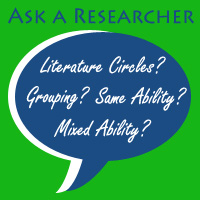
by Sharon Vaughn
The University of Texas
July 29, 2013
Question:
I teach a 4th grade self-contained class. I am a huge proponent of reading of all types—from magazines to wordless picture books. I have always supported the use of literature circles within the classroom. I have typically always used a same-ability grouping for students in literature circles. My question is: What type of grouping works best—same ability or mixed ability?
Response from Sharon Vaughn:
It is important to consider what grouping practice is most effective for engaging readers and promoting successful outcomes. Fortunately, the answer is not limited to choosing between mixed- and same-ability grouping. The most successful grouping procedures in classrooms involve a range of grouping structures that are selected based on the learning needs of the students and the instructional goals of the teacher. One of the important decisions you have made that is associated with improved outcomes in reading is to provide small group instruction for your students (Taylor, Pearson, Clark, & Walpole, 1999).
 Let’s specifically consider the question asked about same- and mixed-ability grouping for literature circles. You may know that until the 1990s, students were grouped for reading instruction into relatively homogeneous groups based on teachers’ judgment of ability, placement tests, and/or previous grouping arrangements (Barr & Dreeben, 1991; Kulik & Kulik, 1982). Most teachers divided students into three or four reading groups within their class. Occasionally, teachers grouped students with students from other classes who had the same perceived reading ability and needs.
Let’s specifically consider the question asked about same- and mixed-ability grouping for literature circles. You may know that until the 1990s, students were grouped for reading instruction into relatively homogeneous groups based on teachers’ judgment of ability, placement tests, and/or previous grouping arrangements (Barr & Dreeben, 1991; Kulik & Kulik, 1982). Most teachers divided students into three or four reading groups within their class. Occasionally, teachers grouped students with students from other classes who had the same perceived reading ability and needs.
Why has this practice changed? First, research revealed that students who were the poorest readers received instruction of poor quality focusing on isolated skills, with minimal time for reading connected text (Hiebert, 1983). Even students appearing to read at the same level may have very different instructional needs (Buly & Valencia, 2002). Also, there was inadequate opportunity for students to move between groups, influencing students’ self-perceptions and friendship choices (Hallinan & Sorensen, 1985; Oakes, Gamoran, & Page, 1992). However, effective teachers can overcome many of these problems associated with same-ability groups by assuring high-quality, responsive instruction to all same-ability groups and using other grouping practices to support student success such as mixed-ability groups, one-on-one instruction, and student pairing. In these contexts, students are grouped not by ability but by other factors such as their interests or consideration of group dynamics.
So, consider providing opportunities for students to work in both same- and mixed-ability grouping structures. Also consider using other grouping formats such as peer-pairing, which can be particularly effective for rereading and promoting fluency, and one-on-one instruction addressing the specific learning needs of students. Our research suggests that these alternative grouping formats are especially important to consider for students with learning disabilities (Elbaum, Vaughn, Hughes, & Moody, 1999). And thank you for your question!
Sharon Vaughn is the H.E.Hartfelder/Southland Corp Regents Chair of Human Development and executive director of the Meadows Center for Preventing Educational Risk at The University of Texas at Austin.
Barr, R., & Dreeben, R. (1991). Grouping students for reading instruction. In R. Barr, M. L. Kamil, P. B. Mosenthal, & P. D. Pearson (Eds.), Handbook of reading research (Vol. 2, pp. 885-910). New York, NY: Longman.
Buly, M.R., & Valencia, S.W. (2002). Below the bar: Profiles of students who fail state reading assessments. Educational Evaluation and Policy Analysis, 24(3), 219–239.
Elbaum, B., Vaughn, S., Hughes, M., & Moody, S. W. (1999). Grouping practices and reading outcomes for students with disabilities. Exceptional Children, 65, 399-415.
Hallinan, M. T., & Sorensen, A. B. (1985). Ability grouping and student friendships. American Educational Research Journal, 22, 485-499.
Hiebert, E. H. (1983). An examination of ability grouping for reading instruction. Reading Research Quarterly, 18, 231-255.
Kulik, C. C., & Kulik, J. A. (1982). Research synthesis on ability grouping. Educational Leadership, 39, 619-621.
Oakes, J., Gamoran, A., & Page, R. N. (1992). Curriculum differentiation: Opportunities, outcomes, and meanings. In P. Jackson (Ed.), Handbook of research on curriculum (pp. 570-608). New York, NY: Macmillan.
Taylor, B. M., Pearson, P. D., Clark, K. F., & Walpole, S. (1999). Effective schools/accomplished teachers. The Reading Teacher, 53, 156-159.
Reader response is welcomed. Email your comments to LRP@reading.org